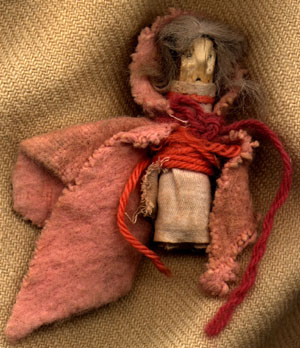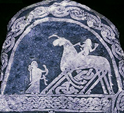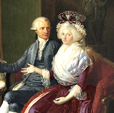Viking Games and Entertainment |
|
| Some Viking poetry and stories (sagas) are still available today. The remains of musical instruments such as drums, whistles and harps have been found on archeological sites. You can imagine the Vikings sitting around their fires in the evening and singing or telling stories while they spun wool. Boardgames such as chess (see the Lewis Chess set) and Kings' Table (where there are two sets of pieces - attackers aiming to capture the King and defenders aiming to get him safely to the edge of the board). Game boards have been found scratched into floors and rocks on archaeological sites and there were also specially made boards of wood or cloth (which could be rolled up and carried easily). Game pieces could be stones, shells, carved wood, bone or ivory, clay figures or anything like that. |
 |
| Games like "catch" and "blindmans buff" seem to go a long way back in history and they used to be played by adults as well as children. | doll made from wood and scraps of material |
| Children in the Viking age wouldn't have had very many toys compared with children today. They would have been helping with house and farm work from when they were quite young. A few toys have been found, though. Dolls can be made from many simple things such as wooden spoons or large pinecones with bits of cloth wrapped around them. Balls can be made of wood or of leather or cloth stuffed with sheep's wool. Other toys might have included small wooden swords and clay animals. How to play Myar You will need a box or pot with a lid and two dice. Each player has three lives (or tokens) Each player in turn shakes the box. A player may look at the dice he/she has cast or choose not to. After shaking the box a player declares a score and passes the closed box to the second player, the second player can either open the box or keep it closed. If the second player chooses to open the box he/she is challenging the first player. If the score in the box is equal to or higher than the one which the first player declared then the second player loses a life, if it is lower then the first player loses a life. If the second player does not wish to challenge the first then they may either pass the box on without shaking it, or after shaking it (after the box has been shaken the second player may open it to look at the dice). Either way the second player must declare a score which is equal to or higher than the previous score. The box is then passed on to the third player. The box can only be passed on once round the circle without being shaken, if it gets back to the player who last shook it he/she must either challenge the score or shake the box again. The way the scoring works is that higher numbers beat lower, except that doubles beat any other combination other than "myar" which is a 2 and a 1. Scores are declared with high dice first. So, from lowest score to highest is : 3,1 ; 3,2 ; 4,1 ; 4,2 ; 4,3 ; 5,1 ; 5,2 ; 5,3 ; 5,4 ; 6,1 ; 6,2 ; 6,3 ; 6,4 ; 6,5 ; 1,1 ; 2,2 ; 3,3 ; 4;4 ; 5,5 ; 6,6 ; 2,1 |
|




